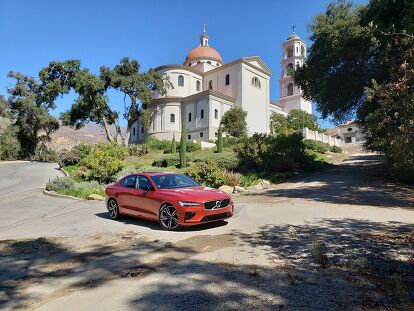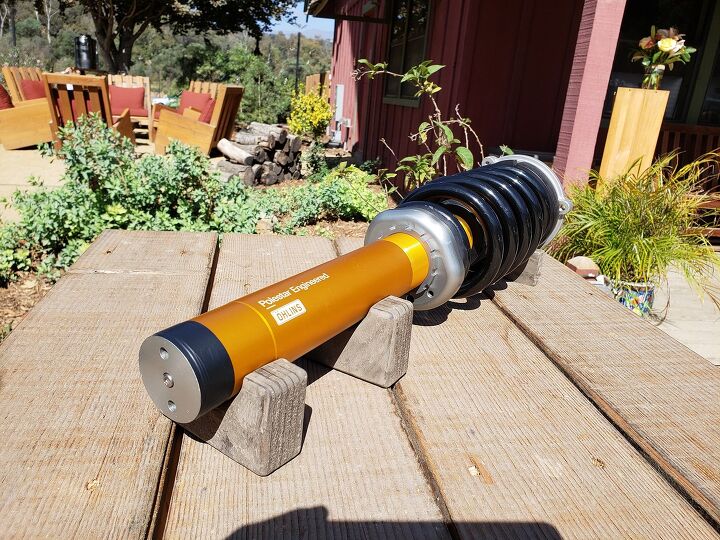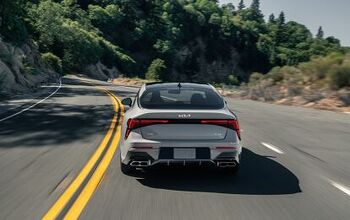2019 Volvo S60 Review: The Best-Driving Volvo Yet

Volvo has spent lots of money and four years rebuilding its lineup. And despite being lauded for its cars’ undeniable style, remarkable quality, and sumptuous luxury, Volvo’s focus was clearly not on driving dynamics. And why should it have been?
But for the final vehicle in Volvo’s updated fleet (S60 Cross Country notwithstanding) Volvo actually has to make some concessions to pace. The segment, long-dominated by the 3 Series (in the public imagination, at least), is still beholden to that oldest of old-school metrics, the lap time. It’s a reality reflected in the segment’s now anachronistic adherence to rear-wheel drive and the former S60’s role as Polestar (now Cyan) race car. And there’s good news for the Volvo faithful because the S60 is the best-driving car in Volvo’s new lineup.
The 2019 Volvo S60 comes in a few flavors and in every trim, it is among, if not the, most powerful car among its peers. Although there isn’t an M3 or an AMG competitor, Volvo has turned to the newly minted Polestar sub-brand for some help on the performance front. The T8 Polestar Engineered S60 is best compared against the likes of the BMW M340i or the Audi S4 and makes a healthy 415 hp despite being (or indeed because it is) a plug-in hybrid.
FAST FACTS
| Engine: | 2.0L I4 (+ 87 HP electric motor, T8) |
| Output: | 316 hp (T6) / 415 hp (T8 Polestar) |
| Transmission: | 8-speed automatic |
| Fuel Economy (US MPG): | 21 city, 32 hwy, 25 combined (27/34/30/72 MPGe, T8 Polestar) |
| Starting Price T6 (USD): | $40,300 |
| Starting price T8 (USD): | $53,700 |
In this age of 700-hp SUVs and 1,500-hp supercars, it’s easy to get lost in the numbers, so let me make it perfectly clear: 415 hp is a lot of power. The Polestar Engineered T8 S60 makes this very clear. On highway onramps and while pulling away from red lights, it pulls you back into your seat in a way that makes drivers giggle and passengers clutch any available handles. That could be put down to the car’s electric drivetrain (although numbers haven’t yet been posted by the EPA, there will be roughly 21 miles of electric-only driving available) but it’s not just from low speeds that it pulls well.
It is a testament to Volvo’s diminutive engines that the T8 continues to feel engaging and accelerate hard through medium-speed corners. And thanks to the electrically assisted rear axle, the car pushes from behind you, as well as pulling you from ahead, completely hiding the S60’s FWD foundations. And if the Polestar Engineered T8’s 415 hp (the regular T8 gets 400 hp) is plenty, the T6’s 315 hp is enough.
ALSO SEE: 2019 Volvo V60 Review
Maybe it has to do the peculiarities of its AWD system, but the T6’s 315 hp feels like slightly less than that. It’s not that it’s slow, it’s just that it doesn’t feel especially hurried. That might have been a conscious decision — Volvo again choosing to value comfort over speed — or it could be that I was spoiled by the T8, but whatever the case, it certainly didn’t feel like a muscle car.
The upshot of that being that neither car felt like a muscle car when I took them out into the hills outside Los Angeles. Both are ideally suited to canyon carving. It would be shameless and unnecessary puffery to call the S60 a hardcore sports car, but that’s only because it feels more like a grand tourer than that. More suited to a good road than a good track, Volvo has judged it perfectly here. Especially with the Polestar Engineered T8 and its special, golden Ohlins dampers, the S60 speeds smoothly and speedily around sweeping bends, making use of its torque to help you link corners together rhythmically. It performs as gracefully as it looks, rewarding smooth inputs and a steady hand.
Steering has long been a complaint of mine in the Volvo stable. The wheel in your hands didn’t feel connected to the wheels on the road in any meaningful way. It was a shock to me, therefore, that the even in T6 guise, the S60 feels so good. There’s still a whiff of numbness about the wheel, but it’s an amazing improvement. The wheel is weighted just about perfectly. It takes a little bit of effort to turn the wheel, but you don’t have to limber up and stretch to avoid pulling a muscle. Volvo has also carefully tuned the suspension to ensure that every move of the front is caught by the back end to make the steering wheel feel instantaneous and the car connected as a whole.
ALSO SEE: 2018 Volvo S90 T8 Review
Again, it’s perfectly judged and it’s why you don’t need a million driving modes (just four) and why there are no active damping adjustments. And what’s good in the normal S60, is fantastic in the Polestar Engineered car. Despite the adjustable valves (just a twist of an easily accessible knob can stiffen or soften the ride), the dual flow valve Ohlins dampers are chosen specifically for their on-road manners. The dampers are endowed with an extra valve that does complicated things with the fluid that suspends the car. The effect of it all, though, is a damper behaves exactly nothing like custard.
Custard is what the kids today are calling a non-newtonian fluid. That means that when subjected to harsh shocks, it becomes stiff, but is liquidy enough for your spoon gloop into when you move slowly. Ohlins dampers, by contrast, are stiff when they feel slow movements and soften when they feel harsh movements. That means that when you hit a crack in the road or (god forbid) a pothole, they acquiesce, not bothering your butt with the shock. But through a long, sweeping bend, they’re as stiff as you like. It keeps the car level, stable, and engaging through the corners without giving up comfort.
The best way I can sum it up is by repeating another journalist who said that it wasn’t the best car in the class, he just liked it the most. It is absolutely not the fastest or the most engaging car to drive in its class, but it just feels right. It’s Goldilocks… or Goldidampers?
It’s quick, it’s fun, and it might be the best looking car in the class. That said, it might also be the least attractive Volvo in the new fleet. That’s, admittedly, a high bar, but I’m not a fan of the S60’s rear arch crease and its profile is still a little too wedgy for my tastes. It is, by no means, ugly, I just don’t love it like I do the S90.
Similarly, although it has less room in the back than the S90 (obviously, I just needed a connecting clause) its back seats are much more comfortable than the competition’s. The back seats actually feel like seats and a person with knees — knees that are attached to thighs, even — could fit comfortably in the back seat. That’s not always exactly true of cars in this segment, which often cut corners back there by sacrificing leg room for the front’s La-Z-Boys. Worse yet, they seemingly put leather-wrapped planks of plywood where the seats should go. And the S60 doesn’t. And while that may sound like Volvo’s doing the bare minimum, it, apparently, isn’t. So it’s worth noting.
The S60 also benefits from all of Volvo’s years of safety technology and introduces oncoming collision mitigation. The new safety technique uses the car’s sensors to prepare itself to slow in the event that an oncoming vehicle strays out of its lane (or you out of yours). If it sees a car coming, the S60 will help maximize brake pressure if it determines that a crash is inevitable to try and slow you down as much as possible.
I’ve been very kind to the car not just because it’s good, but also because it surprised me. Something I had assumed a Volvo could no longer do. There are, however, still some flat spots. Volvo’s Sensus infotainment system, for instance, still sucks. The company claims to have improved the 8 or 9-inch (depending on trim) infotainment system’s computing power by 50%, but if that’s the case, it should have been improved by 100%. When searching for a destination or trying to do anything more than the bare minimum on the tablet-style touchscreen, the screen still lagged and did lose me on the map at one point.
ALSO SEE: 2019 Volvo XC40 vs 2018 BMW X1
Volvo’s adherence to minimalism could also use some compromise. Granted, the simplicity of Volvo’s button designs looks great, but it’s not exactly easy to use. This isn’t just a steep learning curve. I have been in many Volvos and I have spent a lot of time using Sensus, but I still find it hard to complete simple tasks like find FM radio, move the head-up display into view, or use the digital dashboard. Worse still, I effectively have to pull over to figure it out because everything is hidden behind menus.
And god forbid you try to adjust your seat while a turn in your navigation is coming up because figuring out which part of the seat you’re adjusting blacks out the whole screen to tell you which part of the seat (lumbar? Massage? Under knee bolster?) you’re adjusting. These aren’t problems any other carmaker faces because they accept that a few buttons are useful, and maybe even necessary. It’s a little mystifying from Volvo of all brands because the system from the company that is most dedicated to safety counts among the ones I find the least safe to operate.
It’s also mystifying (though on a much less important, and much pettier scale) that a company so committed to design would let such a terribly integrated Polestar badge leave the factory. The white square looks like about as at home on S60’s trunk as a post-it note. It literally doesn’t matter but is also stands out because the rest of the car is so carefully designed. They spent time hiding one of the car’s back up sensors, but couldn’t find a more elegant way to incorporate the Polestar badge into the car?
The Verdict: 2019 Volvo S60 Review
But these flaws are easily overlooked when compared against the rest of the S60. Even though it’s not my favorite Volvo design, it’s still head and shoulders above BMW’s upcoming 3 Series, and though it’s not the best driver in the segment, it’s more than a little bit rewarding when the going gets twisty. This is an ably designed car and seeing as it’s Volvo’s most affordable (though not cheap) car, I sincerely hope the market will recognize Volvo’s hard work. From a completely selfish point of view, it would be nice to see more Volvos on the road.
Discuss this article on our Volvo Forum
LOVE IT
- Nice drive
- Dearth of drive modes
- Comfortable, safe, and good to look at
LEAVE IT
- Infotainment still leaves much to be desired
- Least attractive modern Volvo
- Minimalist to a fault

Sebastien is a roving reporter who covers Euros, domestics, and all things enthusiast. He has been writing about the automotive industry for four years and obsessed with it his whole life. He studied English at the Wilfrid Laurier University. Sebastien also edits for AutoGuide's sister sites VW Vortex, Fourtitude, Swedespeed, GM Inside News, All Ford Mustangs, and more.
More by Sebastien Bell































































Comments
Join the conversation
Sebastien did an amazing job on this review. Great read. I'm not a Volvo fan but thoroughly enjoyed the review and points highlighted. Great work